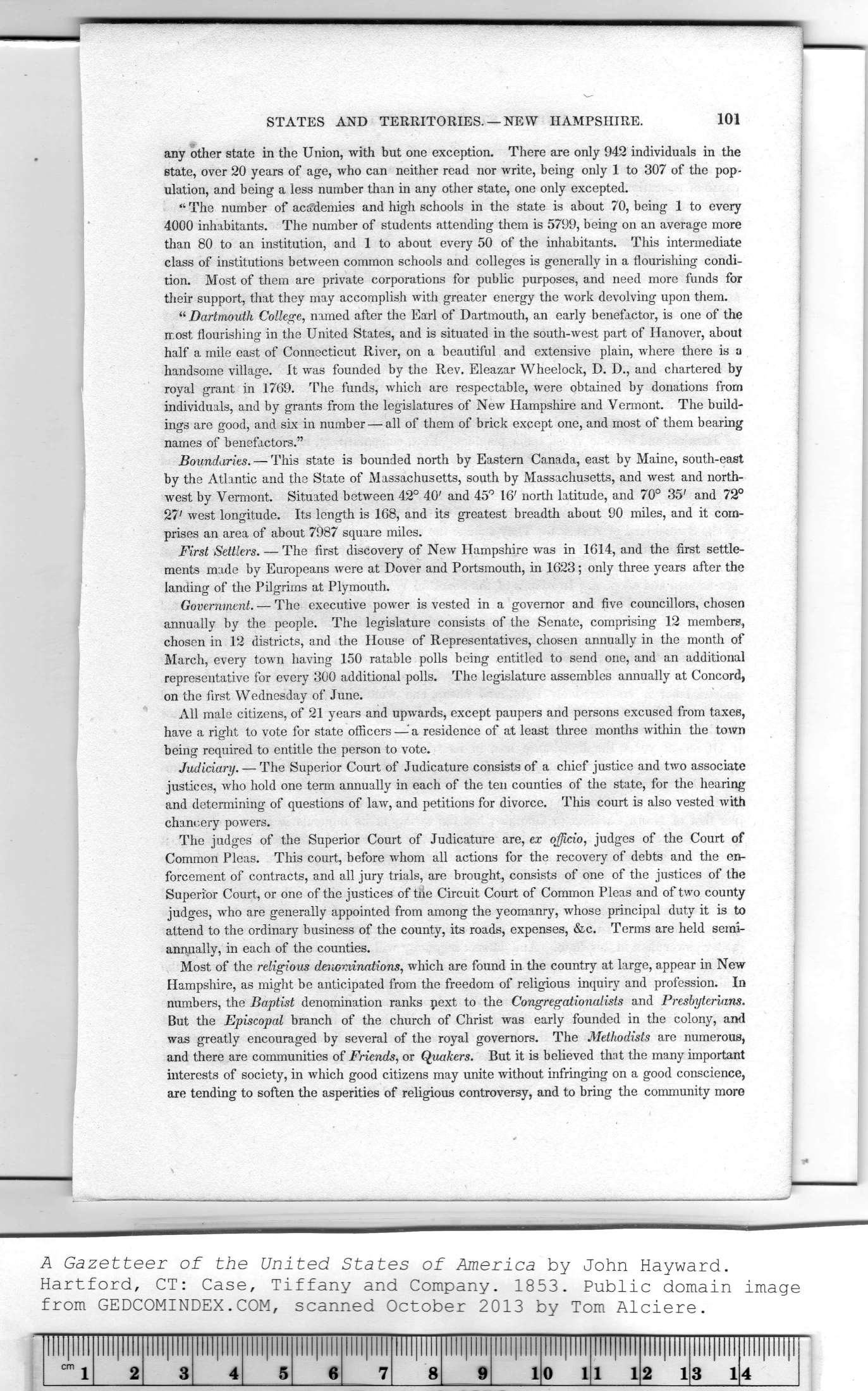|
|
Note: Ctrl and + increases the font size of the text below, Ctrl and - decreases it, and Ctrl and 0 resets it to default size.
STATES AND TERRITORIES.— NEW HAMPSHIRE. 101
any other state in the Union, with but one exception. There are only 942 individuals in the
state, over 20 years of age, who can neither read nor write, being only 1 to 307 of the pop-
ulation, and being a less number than in any other state, one only excepted.
“ The number of academies and high schools in the state is about 70, being 1 to every
4000 inhabitants. The number of students attending them is 5799, being on an average more
than 80 to an institution, and 1 to about every 50 of the inhabitants. This intermediate
class of institutions between common schools and colleges is generally in a flourishing condi-
tion. Most of them are private corporations for public purposes, and need more funds for
their support, that they may accomplish with greater energy the work devolving upon them.
“ Dartmouth College, named after the Earl of Dartmouth, an early benefactor, is one of the
irost flourishing in the United States, and is situated in the south-west part of Hanover, about
half a mile east of Connecticut River, on a beautiful and extensive plain, where there is a
handsome village. It was founded by the Rev. Eleazar Wheelock, D. D., and chartered by
royal grant in 1769. The funds, which are respectable, were obtained by donations from
individuals, and by grants from the legislatures of New Hampshire and Vermont. The build-
ings are good, and six in number — all of them of brick except one, and most of them bearing
names of benefactors."
Boundaries. — This state is bounded north by Eastern Canada, east by Maine, south-east
by the Atlantic and the State of Massachusetts, south by Massachusetts, and west and north-
west by Vermont. Situated between 42° 40' and 45° 16' north latitude, and 70° 35' and 72°
27' west longitude. Its length is 168, and its greatest breadth about 90 miles, and it com-
prises an area of about 7987 square miles.
First Settlers. — The first discovery of New Hampshire was in 1614, and the first settle-
ments made by Europeans were at Dover and Portsmouth, in 1623; only three years after the
landing of the Pilgrims at Plymouth.
Government. — The executive power is vested in a governor and five councillors, chosen
annually by the people. The legislature consists of the Senate, comprising 12 members,
chosen in 12 districts, and the House of Representatives, chosen annually in the month of
March, every town having 150 ratable polls being entitled to send one, and an additional
representative for every 300 additional polls. The legislature assembles annually at Concord,
on the first Wednesday of June.
All male citizens, of 21 years and upwards, except paupers and persons excused from taxes,
have a right to vote for state officers —' a residence of at least three months within the town
being required to entitle the person to vote.
Judiciary. — The Superior Court of Judicature consists of a chief justice and two associate
justices, who hold one term annually in each of the ten counties of the state, for the hearing
and determining of questions of law, and petitions for divorce. This court is also vested with
chancery powers.
The judges of the Superior Court of Judicature are, ex officio, judges of the Court of
Common Pleas. This court, before whom all actions for the recovery of debts and the en-
forcement of contracts, and all jury trials, are brought, consists of one of the justices of the
Superior Court, or one of the justices of tiie Circuit Court of Common Pleas and of two county
judges, who are generally appointed from among the yeomanry, whose principal duty it is to
attend to the ordinary business of the county, its roads, expenses, &c. Terms are held semi-
annually, in each of the counties.
Most of the religious denominations, which are found in the country at large, appear in New
Hampshire, as might be anticipated from the freedom of religious inquiry and profession. In
numbers, the Baptist denomination ranks next to the Congregationalists and Presbyterians.
But the Episcopal branch of the church of Christ was early founded in the colony, and
was greatly encouraged by several of the royal governors. The Methodists are numerous,
and there are communities of Friends, or Quakers. But it is believed that the many important
interests of society, in which good citizens may unite without infringing on a good conscience,
are tending to soften the asperities of religious controversy, and to bring the community more
A Gazetteer of the United States of America by John Hayward.
Hartford, CT: Case, Tiffany and Company. 1853. Public domain image
|
